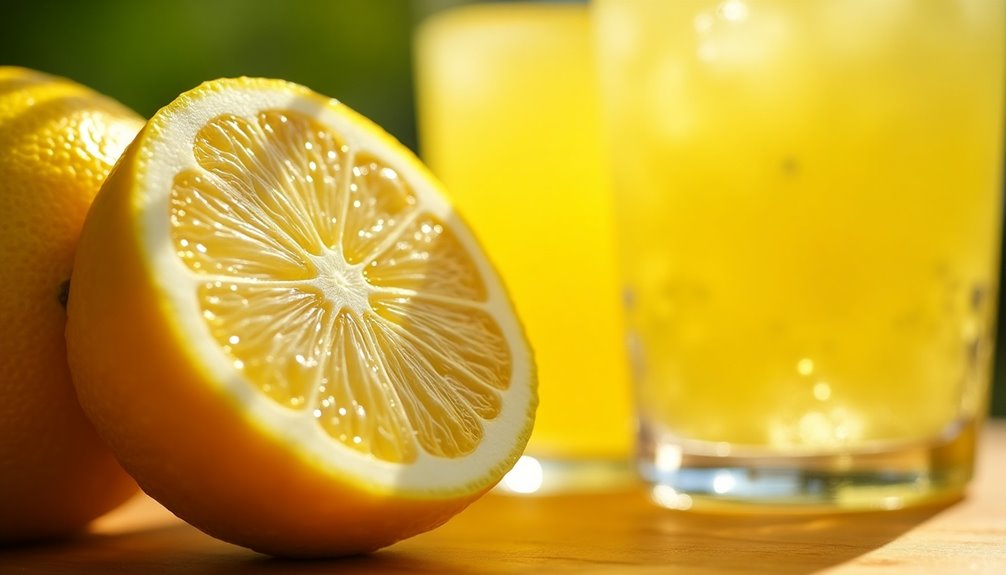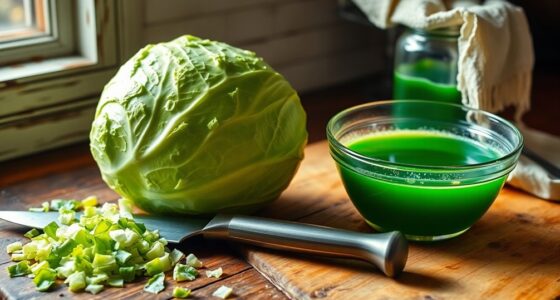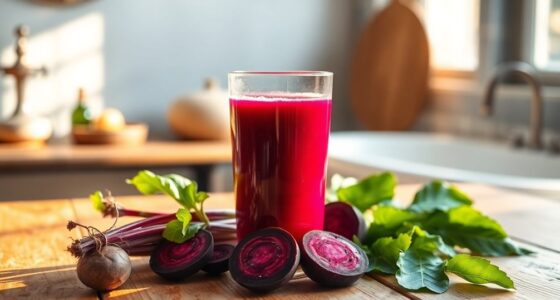A medium lemon usually gives you about 2 to 3 tablespoons of juice, while a larger lemon can yield up to 1/4 cup, or 4 tablespoons. If you need a full cup of lemon juice, expect to use around 5 to 5.5 lemons. Remember, the type and freshness of the lemon can impact juice output. Want to get the most juice from your lemons? Discover some tips to maximize their yield.
Key Takeaways
- A medium lemon yields about 2 to 3 tablespoons of juice, while larger lemons can yield up to 1/4 cup (4 tablespoons).
- Approximately 5 to 5.5 regular lemons are needed to make a full cup of lemon juice.
- Meyer lemons are generally smaller but juicier, often yielding more juice than standard lemons.
- Warming lemons before squeezing can increase juice yield by about 1.5 times.
- Using a citrus juicer helps maximize juice extraction, ensuring you get the most juice possible.

Have you ever wondered how much juice you can get from a lemon? It's a question that pops up often, especially when you're trying to whip up a delicious dish or a refreshing drink. The answer, though, isn't as simple as it might seem. The amount of juice you can extract from a lemon varies based on factors like its size, ripeness, and even the variety of lemon you're working with.
Typically, a medium lemon yields about 2 to 3 tablespoons of juice. If you're lucky enough to have larger lemons, you might get up to 1/4 cup, or 4 tablespoons of juice, from just one squeezed lemon. When you're in the kitchen, these measurements can really make a difference in your recipes. You might find that it takes around 5 to 5.5 lemons to make a full cup of lemon juice, which is good to know if you're planning to make a big batch of lemonade or a zesty vinaigrette.
But what if you're using a Meyer lemon? These delightful fruits are generally smaller yet juicier than regular lemons. Because of their higher juice content, you might find that you can extract a bit more from a Meyer lemon compared to a standard lemon. So, if you're aiming for a particular lemon flavor in your dish, choosing the right lemon can enhance your culinary experience.
Sometimes, you might get a bit more juice than expected from a fresh lemon. Users have reported yields varying from 3 to even 6 tablespoons per lemon, depending on its condition. If you're ever in doubt, feel free to squeeze a few more lemons to hit that perfect amount of juice. You wouldn't want to end up short when making a tangy lemon meringue pie or a mouthwatering lemon tart!
Here's a little tip for maximizing your lemon juice yield: try warming your lemons in the microwave for about 10-20 seconds. This simple trick can increase the amount of juice you can extract by approximately 1.5 times. It's a game-changer when you're in a rush and need that extra lemon flavor in your dish.
When you're ready to squeeze, remember that the method matters, too. Use a citrus juicer or your hands to apply even pressure while squeezing the lemon. This helps extract every last drop of that zesty juice, ensuring you get the most out of each lemon.
Frequently Asked Questions
How Much Lemon Juice Is in 1 Lemon?
When you’re squeezing a lemon, you can expect to get about 2 to 3 tablespoons of juice from a medium-sized fruit. This amount of juice is perfect for adding a refreshing zing to your dishes or beverages. Additionally, it’s worth noting that while lemon juice is low in calories, the carbohydrate content in lemon juice is minimal, primarily consisting of simple sugars. Consequently, it can be a flavorful and healthy addition to your diet without significantly impacting your overall carbohydrate intake.
If you've got a larger lemon, it might yield even more—up to 1/4 cup!
Keep in mind, the juice amount varies based on size and ripeness.
For a better yield, try warming the lemon in the microwave for a few seconds before juicing. It can really help you get more juice!
Can You Substitute Bottled Lemon Juice for Fresh Lemon Juice?
Did you know that one medium lemon can yield about 2-3 tablespoons of juice?
You can definitely substitute bottled lemon juice for fresh lemon juice, but keep in mind that the flavor mightn't be as vibrant. A common rule is to use 1 tablespoon of bottled juice for one small lemon.
Always taste your dish as you go, adjusting the amount based on your preference, since fresh juice packs a more intense punch.
How Much Real Lemon Juice Is Equal to a Lemon?
When you're measuring lemon juice, one medium lemon typically yields about 2 to 3 tablespoons.
So, if a recipe calls for the juice of one lemon, you can start with about 3 tablespoons.
Keep in mind that personal preference and the size of the lemon can affect the amount.
If you want to maximize your yield, try warming the lemon in the microwave for a few seconds before juicing.
Is 100% Lemon Juice in a Bottle the Same as a Lemon?
Picture a vibrant lemon, bright and dimpled, bursting with juice.
Now, imagine a bottle of 100% lemon juice—it's convenient, sure, but it lacks that fresh zing.
You won't get the same depth of flavor or aroma from the bottled version.
While both might add acidity to your dish, the bottled juice often contains preservatives that can dull its taste.
Conclusion
In the end, you've got about two to three tablespoons of juice in a medium lemon. So, when life hands you lemons, squeeze them for all they're worth! Whether you're whipping up a zesty dish or a refreshing drink, knowing how much juice to expect helps you hit the right flavor notes. Remember, each lemon's a little treasure chest of tangy goodness waiting to brighten your culinary creations. So go ahead, let that citrus shine!
Cindy thoroughly researches juicing trends, techniques, and recipes to provide readers with practical advice and inspiration. Her writing style is accessible, engaging, and designed to make complex concepts easy to understand. Cindy’s dedication to promoting the advantages of juicing shines through her work, empowering readers to make positive changes in their lives through the simple act of juicing.

















